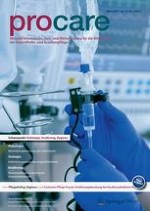Anzeige
01.03.2017 | urologie
Katheterassoziierte Harnwegsinfektionen
Regelmäßige Indikationschecks und Schulungen reduzieren das Risiko
Erschienen in: ProCare | Ausgabe 3/2017
Einloggen, um Zugang zu erhaltenZusammenfassung
Bei liegendem Harnröhrendauerkatheter entwickelt sich eine signifikante Bakteriurie innerhalb von vier Wochen in so gut wie 100 Prozent der Fälle. Durch Katheterinkrustierung infolge ureasebildender Bakterien drohen Katheterverstopfungen bei etwa 40 Prozent der Patienten. Aufsteigende Harnwegsinfektionen, Harnröhrenkomplikationen und Steinbildungen können als Komplikationen auftreten. Durch regelmäßige Ausbildung und Überwachungsmaßnahmen sollte sowohl in Pflegeheimen als auch im Krankenhaus und in der Heimpflege sichergestellt werden, dass die Hygienevorschriften eingehalten werden, die Katheterliegedauer bei strenger Indikationsstellung möglichst kurz gehalten wird und Patienten mit Komplikationen rechtzeitig erkannt und adäquater fachurologischer Diagnostik und Therapie zugeführt werden.
